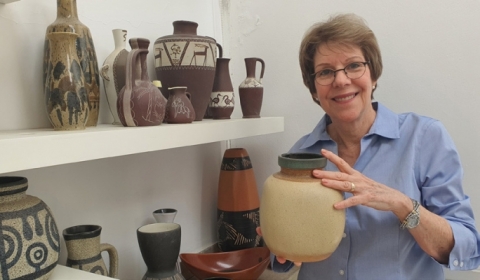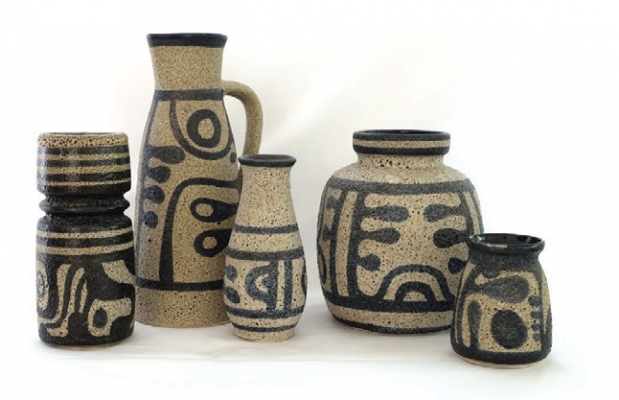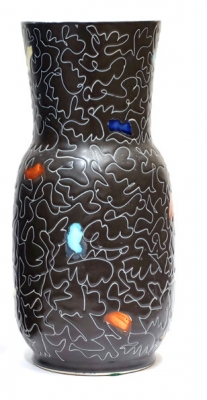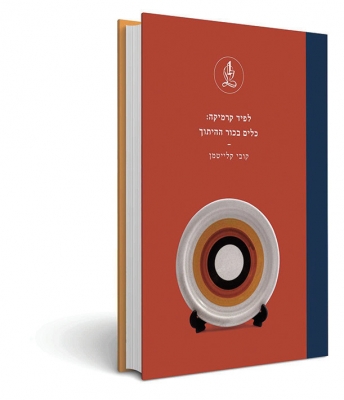Lapid Ceramics: A Melting Pot
Photos by Kobi Klaitman of Lapid ceramic items from the collection of Sharyn Weizman
I've often wondered why some of us become collectors. Is there a need to build and eventually complete a set? Is it the search for the proverbial needle in the haystack? Do collectors find gratification in being surrounded by particularly beautiful or interesting or unusual things? Do they like owning things that no one else has or that others wish they had? Do they crave praise from visitors or do they cherish their collections privately? I know someone who keeps his collection of miniature Japanese silver salt shakers behind lock and key…to be shared with only special people.
I remember my father telling me how he built his stamp collection. In the 30's in New York there were ads in stamp collecting pamphlets. He told me that he saved his allowance in order to buy 5 cents worth of stamps "On Approval." His collection led to a lifetime passion for history and geography.
I wasn't interested in collecting stamps but have always loved flea markets. One Friday morning about 20 years ago, I set off to Jaffa to explore the flea market. I've always loved blue and white dishes and thought that would be a nice thing to begin collecting. Lo and behold, no matter where I looked, there was no blue and white European porcelain to be found. I was just about to head home empty-handed when I discovered a shop bursting with goods. When I told the owner what I was looking for, she told me simply "you're in Israel now, you must collect Israeli blue and white!" And she unlocked a special cabinet to show me what she meant. It was full of blue and white Israeli plates, dishes and tableware. It was love at first sight. She told me the pattern was called Arabesque (some think it was inspired by Meissen's Blue Onion pattern rather than anything middle-eastern). I chose a small plate which the kind shop owner gifted me – she must have seen a potential client-collector. When I turned it over I was delighted to see that on the bottom it read: "Lapid Israel, hand-painted by Batia."
I loved my new plate and began visiting the Jaffa flea market once or twice a month. Little by little I started collecting Lapid ceramics exclusively. One of the old-time shop keepers at the market told me that he had worked in the Lapid factory and that it had been located on Eilat Street in Tel Aviv. He kept very large and very beautiful Lapid vases in the back of his shop, so that's where I headed every time I went to the shuk. He was reluctant to part with them, but as he saw I was becoming an avid collector he always showed me one he had put away for me. They were pricey but collectors can't be stopped. And so my collection grew. I discovered the Friday morning Dizengoff Circle market (which sadly doesn't exist anymore), where I met some very nice vendors and my collection grew some more. One of the vendors, Yonatan Livny, from whom I bought several impressive Lapid pieces advised me to stick to collecting one brand of ceramics. I'm glad I heeded his advice. Yonatan went on to become a professional auctioneer and opened the very popular and respectable Ishtar Arts auction house. And of course, there was eBay where Israeli ceramics were affordable, even with shipping.
I became very curious to know more about the now-closed Lapid Ceramics Company. I tried to find something about the history of the company but there was very little to be found. At Beit Ariela in Tel Aviv I discovered a Hebrew/English catalog called The Beginnings of Israeli Ceramics 1932-1962, published by the Herzliya Museum in 1991. I photocopied the catalog and savored reading it. I didn't search any further but remained very curious.
When COVID struck in March of 2020 I began, at my children's request, to catalog my collection. I searched online and I was able to find items identical to mine on eBay, Pinterest and Etsy. I saved and printed pages that matched items in my collection, and tucked the printed slips into vases and bowls. I was in for some surprises. One vase that I had bought for 45 shekels several years ago in the shuk was listed for nearly $400 on eBay. At last I sat down at the computer and began to document my inventory. First I counted how many Lapid pieces I have – I haven't added to my collection in years, so I was very surprised to find that I have almost 500 pieces. I have the pieces arranged by pattern (not knowing then that the patterns have names) so I had a good jumping off point. And finally I decided to see if, as opposed to the last time I searched several years ago, anything more was now available about Israeli ceramics on the Internet. I was thrilled when I found that an article about Lapid, published in C20Ceramics, contained a link to a Lapid Ceramics Facebook Group.
I learned that the group was established by Kobi Klaitman and that he would soon be publishing the first and only book ever written about an Israeli ceramics manufacturer: Lapid Ceramics: A Melting Pot. Pure serendipity.
I immediately joined the Lapid Ceramics group on Facebook and there I found that Kobi is not just very knowledgeable but he's a very encouraging moderator. I also found that the members of the group, of which there are almost 2,000, have shared interests – collecting and displaying Lapid pottery, posting photos of their favorite pieces, asking questions and putting pieces up for sale too. I felt right at home.
I began taking pictures of my collection and uploading some of them to the Lapid Ceramics Facebook group. Kobi's input made it very interesting. He knows the names of every pattern, the years each pattern was produced, and something about the artists whose handwritten names are found on the bottom of the pieces.
When his book became available I went to his home to pick up my copy, expecting to see a fantastic collection – only to learn that Kobi isn't a collector and owns just a few Lapid pieces. Kobi told me that everyone who came to pick up his book had the same expectation – surprise… and perhaps disappointment too. He focuses on photographing and cataloging other people's Lapid collections.
But I was overwhelmed with his book. Lapid Ceramics: A Melting Pot is a combination history book, catalog and attractive coffee-table book. Kobi describes the iconic Lapid Ceramics factory – how it came into being during the British Mandate in 1943 as a producer of sanitary ware, developed into Israel's legendary producer of art pottery in 1949, and continued to produce beautiful dinnerware and gorgeous museum quality vases until its closure in 1990.
The book describes the importance of the factory to the young Israeli economy, both as an employer and as an exporter. It also gives details of the various phases of ownership and management the factory went through during its 47 years.
Interesting historical black and white photos of the factory workers producing sinks and toilets draw the reader right into the look and feel of the period. Other photos show the potters at their wheels, the designers and artists painting and/or etching the beautiful designs on the pieces, and the shelves laden with pieces set out to dry. Seeing photos of some the artists whose signatures adorn pieces in my collection was a delight.
The production process and the importance of the huge, continuously burning tunnel kiln are described. Other chapters catalog the artists' names and signatures, another presents the Lapid stamps and logos (an intertwined L ל was the first one) and another illustrates the shapes of the vases, jugs, teapots and pitchers by catalog number. Later chapters boast photographs of some of the important visitors to the factory, including David Ben Gurion, Abba Eban and Teddy Kollek.
Most impressive to me is the 175-page Catalog of Lapid art pottery which includes hundreds of beautifully curated photographs. In order to include them, Kobi visited collectors all over Israel and took nearly 3,000 professional photographs. The photos are esthetically arranged both in groups and individually, sometimes by pattern, other times by shape and size. Details about the designs and designers are included for most. There are also quaint advertising pages in English. I found so many familiar pieces and so many others that I'd love to own!
It's the wealth of beautiful photographs that makes this interesting 350-page reference book very attractive to just leaf through and enjoy.
I decided to ask Kobi how he came to write it, and when I heard just part of his story I felt that it was something I wanted to learn more about and share. He agreed to be interviewed for the ESRA magazine and to let us include some of his photographs.
Kobi, I understand that you're a food and wine writer. What is your connection to Lapid Ceramics? Why did you decide to write this book?
My father, Rubin Klaitman, was the Production Technician at the Lapid factory. He often brought home imperfect pieces of Lapid and I loved the sound made by shattering them! It was a kind of game for me. The factory was also a place where I spent school and summer holidays. Sometimes I could even hold a paintbrush and design a piece or two. I was attached to the place and became curious about its history.
The book, Lapid Ceramics: A Melting Pot, is a double tribute: to my father and to the factory and actually to the entire Israeli ceramics manufacturing industry which no longer exists.
How did you gather information about a company that existed and closed so many years ago?
I spent eight years collecting information from various archives. I searched for descendants of the first factory manager and when I couldn't find any, I hired a private investigator to search for them. It was not easy to locate the workers, most of whom did not stay in touch with each other after the factory closed. It was probably too traumatic for them. But it was important for me to find them and include in the book all the people behind the factory, from the CEO and designers to the tunnel kiln operator and to the guard.
Luckily, some of the workers kept documents and catalogs at home that helped me complete the puzzle, and over time I accumulated so much information that I felt I could not keep it with me, even though the cost of publishing the book was very high. I started with crowd funding, but also invested a lot of my own money which I took from my savings and my study fund.
What made Lapid Ceramics stand out, become so popular and endure?
I believe that some of the reasons Lapid Ceramics succeeded where others didn't are:
- The wide selection of shapes, patterns and colors.
- The strength and durability of the products.
- The fact that all of the dishes are lead-free.
- The fact that customers could buy replacement pieces, additional serving and decorative pieces in their preferred patterns.
Also, the artists' signatures on the bottom of most pieces made each piece unique….and very collectable today.
I love the beautiful designs, patterns and colors of Lapid ceramics – some are geometric, others have rough textures, some are brightly glazed and others unglazed. I especially like the small etched pieces with gazelles, birds, and Bedouin women. What was the source of the inspiration?
There were a few highly-trained designers who were born abroad and/or studied in Europe, the best-known being Elsbeth Cohen who created the shapes and forms. Several talented artists painted the designs onto the ceramics. In Israel inspiration came from the desert colors; from archeological pieces discovered in the area. The various Lapid patterns took names like Negev, Arava and Ein Gedi. But Scandinavian and European pottery were also important influences.
In its heyday in the 70's a set of Lapid dishes was a popular and very prestigious wedding gift. Tourists bought many Lapid vases which today are found all over the world. What changed that?
During the 1980s Lapid started to decline – first artistically, then financially. Lapid's closing in 1990 is also part of Israel's story. There are a few reasons for the factory closing: the government opened Israel up for import; Koor collapsed, creating thousands of unemployed; the expensive real estate Lapid was located on (Rehov Eilat in Tel Aviv near Yaffo); and changes in public tastes. People started opting for lighter and cheaper dishes from overseas rather than Lapid's heavy and expensive tableware, even if it was of higher quality and lead-free.
Are any ceramics commercially produced in Israel today?
Israel used to have a thriving ceramics industry with 24 different factories. Lapid, Harsa (a sanitary ware manufacturer that produced artware that is very collectable today) and Naaman were prominent in this group. Today nothing of this important industry remains.
I hope that someone else will write about other Israeli ceramics factories. It's important to make the information and photographs available to the public and not to just leave them in the archives.
Your book was published in November 2020. Who is buying and reading it?
Lapid Ceramics: A Melting Pot appeals to different audiences, for example: collectors and lovers of vintage, of course, people interested in Israeli history and art, academics, and ceramicists. I believe that anyone who is interested in interior design, architecture, and industrial design will want to read and be inspired by it. Israelis living abroad already enjoy its nostalgia. Someone once said that "There's hardly a home in Israel that doesn't have at least one piece of Lapid pottery somewhere!"
It appears that my book has generated a lot of interest in Lapid ceramics. Vintage is very "in" these days and ceramics from the 60's and 70's are popular, not just in Israel, but all over the world. And from what I hear from people who have bought it, you don't even have to read Hebrew to enjoy it!
Today there's a tremendous revival in the popularity of Lapid ceramics, especially evident on your Facebook group and at Israel auctions.
For years collectors have haunted antique fairs, flea markets and secondhand shops both near home and around the world. But collectors no longer need to leave home to enhance their collections. The Lapid Ceramics Facebook group is increasingly active for buying, sharing information, selling or just browsing.
You mentioned that you have some exciting news regarding Lapid Ceramics. Can you please share it?
In April I learned from the Tel Aviv municipality that the site of the former Lapid Ceramics factory on Eilat Street, and the adjacent areas, have been designated to include a Four Seasons hotel, residences and more. It will be called the Lapid Complex. I'm hoping to convince the mayor, architects and designers of the new complex to include a Lapid Ceramics gallery inside the hotel or in one of the buildings to be historically restored in order to document and preserve the history behind the Lapid name.
Where can readers order a copy of your book?
Kobi's book, Lapid Ceramics: A Melting Pot can be ordered This email address is being protected from spambots. You need JavaScript enabled to view it. from its author, Kobi Klaitman, (This email address is being protected from spambots. You need JavaScript enabled to view it.), or via his Facebook group Lapid Ceramics www.facebook.com/groups/lapidceramics.
Author's Note: I don't actively collect any more….I've simply run out of display space… but I love using my Lapid dishes and vases. I follow the prices on eBay and on Israeli auctions and am constantly amazed. There are more than 200 active Israeli auction sites (listed in the Bidspirit portal), many of them featuring Lapid pieces.
The prices for large Lapid items have gone through the roof. In March 2021 a very large vase sold for $2,400. I think I had better insure my collection.
More about Lapid ceramics by Nina Reshef
I want to thank ESRA Magazine for including Sharyn Weizman's engaging article on her collection of Lapid ceramics in your last issue (June 2021). The short piece brought back many memories. I still have a Lapid stoneware sugar bowl, which I bought when setting up house in Israel. I was delighted by the ceramic figure of Srulik* on the cover, which captures the innocent hope and sense of adventure that accompanied me when making aliyah. The article gave me some insight into how the company's name, which means a torch or guiding light, came to be reflected in its operations, especially in its first decades.
Quite frankly, it was new to me that Lapid had maintained a department for producing ceramic art, which got me talking to my partner, who had worked in the firm's technical department in the early 1970s. Memories from that period still enchant him.
He described the plant's comfortable ambience despite the amazing amount of dust and noise resulting from the production process. Instead of spending time only with electric cables and machines, he was able to observe, for the first time, how clay, paint brushes, pottery wheels and ovens heated to 1,250 degrees Celsius could produce beautiful works of art when handled by talented people. It seems that Lapid ensured its aesthetic quality by recruiting its designers, primarily women, from Jerusalem's Bezalel Academy of Art and Design. Some of the staff, such as Maude Friedland and Zehava Goshen, would acquire reputations as independent artists in other media. Others would continue creating new designs for Lapid dinnerware and vases.
Thank you again, Ms. Weizman and ESRA Magazine for a lovely entry into an unknown part of Israel's history.
*Srulik is a cartoon character symbolizing Israel. He was created in 1956 by the Israeli cartoonist Kariel Gardosh, known by his pen name Dosh. Srulik appeared for many years in countless cartoons published in the daily newspapers Maariv and Haaretz.
Nina Reshef
Tel Aviv











Comments